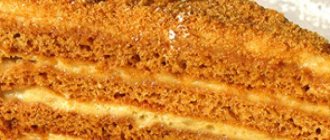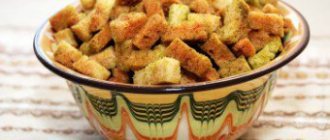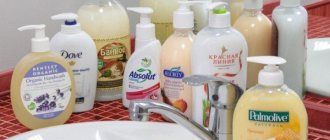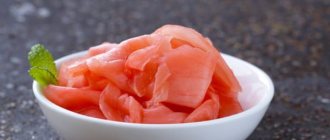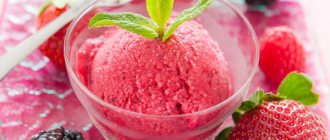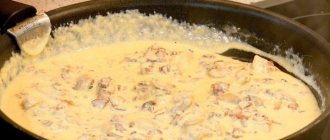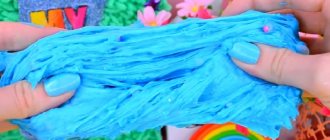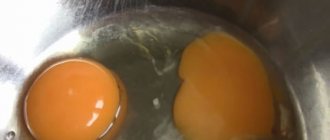Important nuances before starting work
Before making your own soap, there are several important details to consider:
- Essential oils. They are highly concentrated, and if you add too much of them, you will encounter unexpected consequences: from an allergic reaction to chemical burns. Always test products on a small area of skin: apply and observe the reaction after 30 minutes. If no redness appears, then you can safely use the soap.
- Containers. Do not use containers that have been cooked in to prepare or store food. For foamy hobby there should be separate dishes.
- Always keep an antiallergic drug on hand just in case, since any new component can cause an allergy.
- Soap making for beginners involves the use of simplified versions of the procedure. Use soap making recipes using purchased white and transparent bases, or baby soap.
Where to buy ingredients for soap making
- Beginners often have a question about where to buy soap making products? This may be a special store for these purposes, but not every city or town has one. It is better to explore the range of online stores, or use the AliExpress service.
- The base for soap making is presented in colorless (jelly-like) and white (cream) forms. It is better to buy the English one, and from the Chinese only the “premium” option.
- In addition to the base, you can also buy everything for soap making there: shiny decor, molds, dye and other interesting accessories.
What you need to create New Year's soap
To make soap with your own hands, it will be difficult for beginners to do the work from scratch, so we recommend a simplified version of preparing a gift for the New Year.
For the middle piece take:
- white soap base - 50 g;
- transparent soap base - 50 g.
For aroma and beauty:
- cosmetic oils;
- green food coloring;
- pine needle essential oil;
- needles from fir or Christmas tree, etc.
Besides:
- silicone Christmas tree molds for baking;
- pipette;
- alcohol;
- spoon;
- dried tangerine peel;
- coffee for decoration.
Homemade soap is prepared like this:
- In a water bath, melt a small part of the white base, after dividing it into pieces. Be careful not to let it boil during the process.
- Add cosmetic oil to it if desired, at the rate of 1.5 tsp. per 100 gr. A couple of drops of dye (with a pipette), 10 drops of essential oil.
- If desired, quickly add pine needles and tangerine zest for beauty, and stir until the mixture hardens.
- Pour the mixture into the Christmas tree cookie molds, wait until it hardens, then remove.
- Melt the transparent base, add essential oils and dye to it.
- Place the previously prepared Christmas tree from the white base into a larger mold.
- Be sure to coat the product with alcohol using a brush so that it does not fall apart. You can simply spray alcohol from a spray bottle. Place coffee beans, pine needles or pieces of zest on the tree at your discretion.
- Immediately fill the large mold with melted clear base. Cool and you can take it out.
- Cut off any irregularities with a knife.
DIY New Year's soap will delight your friends and loved ones. It all depends only on your imagination and capabilities.
Making soap from scratch
To make homemade soap, you can either use a special ready-made base, which will make the process easier, or collect remnants and use them. It all depends on your desire and financial capabilities.
Creation from a ready-made base
Step-by-step recipe for making soap.
For 100 g of base take:
- 1/3 tsp. olive oil;
- 3-7 drops of ethers;
- 3-7 drops of aromatic additives;
- 1-7 drops of liquid dyes;
- 1/3 tsp. pigment.
First, the base must be melted. The mass turns out to be evenly melted. Pour in the base oil. Add coloring agents and flavorings. Stir the resulting mass until smooth. Pour into molds.
Add decorations and toppings as desired. Allow the detergent to set. After a day, remove the finished product.
Using remnants
Step-by-step process for making soap from soap remnants at home.
It is possible to choose the remains of used bars as a basis. To make 1 liter of liquid soap, take:
- 50 g of soap;
- 1 liter of clean water;
- 2 tbsp. tinctures of calendula or medical alcohol;
- 3 drops of ether;
- 3 drops of dye (for color it is allowed to use the juice of vegetables and berries);
- 4 tbsp. glycerin.
Grind the soap with a fine grater. Pour water into a container with crushed soap and place the mixture in a water bath. Stir constantly so that no hard lumps remain in the mixture. Remove the container from the stove and cool. Add alcohol and glycerin.
Then the addition of dyes, essential oils and fragrances is required. Stir the resulting mass, pass through a strainer and pour into a prepared container. After hardening, you will receive finished soap.
Recipe for liquid soap lovers
To make liquid soap with your own hands without cooking, follow these recommendations.
Necessary:
- approximately 50 g (half a bar) of solid soap;
- 1 liter of water or herbal decoction;
- 1 tbsp. glycerin;
- colorings or flavorings to taste;
- vitamins, cosmetic oils (optional).
The lazy cooking process is simple:
- Grate the hard half of the piece on a fine grater.
- Pour soap shavings into water or herbal decoction, stir and leave for a day.
- The shavings completely dissolve and turn into a thick, homogeneous substance.
- Pour glycerin, cosmetic oils, flavors and dyes into it.
- Stir everything well.
Distribute the product into jars and you can use it with pleasure.
Cleansing soap
There are many ways to make handmade soap. We described some of them above, but I would also like to talk about the production of a type of cleansing product at home. This product can effectively cleanse your facial skin, and it can easily compete with expensive lotions.
Prepare the following ingredients: a hundred-gram bar of baby soap, two teaspoons of camphor alcohol, one and a half small spoons of glycerin and ammonia, one teaspoon of lemon juice, 50 grams of 3% hydrogen peroxide solution and one glass of water.
Grate the soap, pour it into a half-liter jar of water and leave for several hours so that the shavings swell. As soon as this happens, place the jar in a steam bath and, stirring constantly, heat the suspension. After the composition becomes homogeneous, add both types of alcohol and lemon juice to it. Mix all contents. Continuing to stir, remove the jar from the stove. Leave the mixture to cool. But don't forget to stir it from time to time. Pour peroxide little by little into the still warm “brew.” Mix everything again until smooth. The soap is considered ready immediately after the suspension has completely cooled. That's it: you already know how to make hand soap.
High-quality laundry soap “Granny’s Dream”
Knowing how to make laundry soap with your own hands, you will receive a high-quality product that will not cause any harm to your health. It is prepared on the basis of oils, so you need to take inexpensive and accessible options:
- sunflower oil - 0.8 kg;
- coconut oil - 0.1 kg;
- castor oil - 0.3 kg;
- alkali - 150 mg;
- water - 330 ml.
From the above number of components you will get 1 kg of laundry soap, which smells nice, foams well and is used economically.
Cooking technology:
Important! Working with lye is dangerous, so before you begin, put on an apron, gloves and open the windows.
- Melt the coconut oil in a double boiler. Add the remaining oils.
- Measure out and carefully pour the lye into the water, stirring constantly. Strain the mixture.
- Carefully add the lye solution to the oil mixture, making sure that the temperature of both mixtures is approximately the same. Stir the mixture and then beat with a blender.
- As soon as traces begin to form on the mixture, this is a reason to move it to a saucepan and place it in a water bath. The warming up process takes 3-4 hours.
- Gradually the mass will turn into a gel.
- After 3 hours, you can check the alkaline balance using pH strips. It should be in the range from 8.5 to 10.
- After this, add castor oil, mix and pour into molds lined with film. After 3 days, the product is ready, you can use it to wash dishes, do laundry, and even wash your hair. Shelf life: 3 months.
Recipe No. 3 – Anti-cellulite oil with sea salt and algae
Ingredients:
- Organic soap base – 100 g;
- Medium-ground sea salt – 1 teaspoon;
- Ascophyllum algae – 7 g;
- Mixture of oils (basic + essential) – 1 teaspoon.
Step-by-step cooking instructions:
This handmade soap at home is in no way inferior to store-bought counterparts. This manufacturing option is the simplest of the anti-cellulite homemade soap recipes, as it is prepared very quickly.
- So, melt the base; this can be done either in a microwave oven or in a water bath.
- Add seaweed and salt to it. Gently mix these ingredients.
- Pour in the oil mixture (choose essential and base oils to your taste: orange, lemon, but fennel, geranium, juniper, cinnamon, cypress, lavender oils are no less effective against cellulite), continue mixing the components.
- If none of your seven have made cleansing cosmetics before, it is worth paying attention to the fact that the mold for handmade soap will need to be pre-lubricated with alcohol to better extract
the finished product. - Pour in the soap mixture from the base and let it harden. By adding olive oil you will get your own olive soap.
Important:
When making an anti-cellulite cosmetic product, you can do without a soap base, and use soap from scratch; recipes for its preparation are posted just below. It is better not to make soap with salt based on baby soap, otherwise the mass may separate into flakes and water.
Using baby soap
There are numerous recipes for making soap at home, and it is difficult to immediately figure out the right filler and design. We bring to your attention a soft and moisturizing handmade soap made from baby bars.
- 100 g of simple baby soap without additives;
- 100 ml milk;
- 1 tbsp. l olive oil;
- a couple of drops of your favorite essential oil;
- 1 tbsp. l sugar or honey.
A do-it-yourself soap mold can be either silicone or plastic.
The manufacturing technology is as follows:
- Grate the block, pour hot milk over it and leave it alone for 2 hours.
- Place the milk shavings in a 50-degree water bath, add sugar or honey.
- Dissolve everything without bringing to a boil, remove from heat
- Add olive oil and 3 drops of essential oil.
- Stir, pour into mold and refrigerate.
- Once the soap bar has set, carefully remove it from the mold.
- Dry and the product is ready. It is used for all residents of the house, and even for children.
From remnants
Transforming old remnants into a new product is not particularly labor-intensive. To work you will need 120 g of transparent base, 120 g of soap (colored and chocolate), 6 drops of vanilla, 3 drops of sandalwood and 1 tsp. rapeseed essential oil. You also need alcohol and titanium dioxide diluted with glycerin.
Separate the remnants. Grind some of the chocolate color on a grater. Mix the shavings with 60 g of transparent base, cut into small cubes. Then melt the mixture in a water bath, add vanilla oil and 0.5 tsp. rapeseed Beat everything with a mixer until foamy. Grease the silicone mold with rapeseed oil, then fill it with the prepared mixture.
Melt the colored soaps. Mix them with the remaining base. Pour into another container and add white dye, 0.5 tsp. rapeseed oil and 3 drops of sandalwood. Beat until foamy. Sprinkle the frozen first layer with alcohol. Pour the whipped foam on top. You can sprinkle small brown shavings as decoration. After all layers have hardened, remove the block from the mold and cut.
What mistakes can a novice soap maker make?
The topic of homemade soap making has recently become very popular and has turned into a fashionable hobby. It happens that the first time the result is disappointing, since it does not correspond to the numerous beautiful photos from the Internet.
In order for the process to give you only positive emotions, you should familiarize yourself with possible mistakes and avoid them.
- The substance does not thicken. In this case, 15-20 minutes of beating with a mixer may help.
- Finished pieces crumble or break. If, when cutting, the bar breaks, crumbles, and sometimes even burns your fingers, then it means that it has hardened greatly. This can be caused by a high fat content in the composition or exposure to certain essential oils. This factor does not affect the quality of the product, but only the appearance.
- The piece falls apart. Send it to ripen for 2 weeks or cut it using fishing line or guitar string.
- White plaque. If you are making soap for the first time, and a white coating appears on the finished bar (it is also called “soda ash”), then next time cover the raw soap with a plastic bag immediately after sending it to the mold. And the plaque that appears can be washed off or cut off with a knife.
Important! In household versions, do not confuse plaque with crystallized alkali.
The process of creating soap can turn from routine and necessity into magic. Connect your children to it, so you will spend time usefully and interestingly. What options for the production and design of blocks seem interesting to you? Share your experience in the comments.

